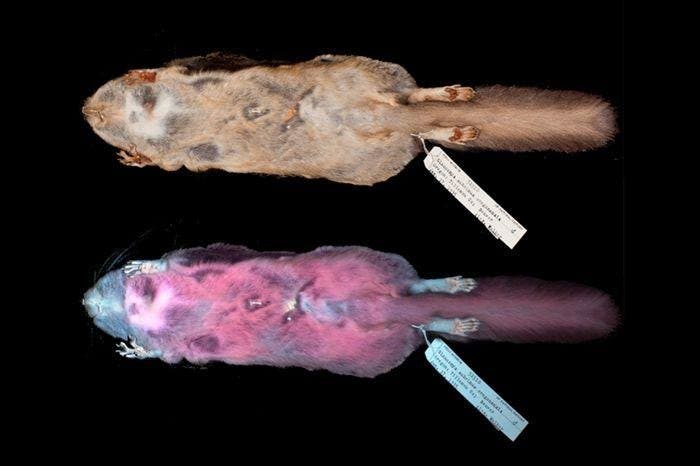A chance sighting revealed that the North American flying squirrel (and its related species) glow bright pink under fluorescent light.

Credit: Kohler et al., (2019), JoM.
Dr. Jon Martin, associate professor of forestry at Northland College in Wisconsin, stumbled upon the discovery in his own back yard. He was doing an exploratory forest survey with an ultraviolet flashlight, trying to find what lichens, mosses, and plants fluoresced. By chance, however, a flying squirrel dining at his bird feeder startled him, and he beamed his flashlight at it — and it glowed pink.
Secretly pink
Martin set up a team to further investigate the issue, which included Allison Kohler, a graduate student in the Texas A&M University wildlife and fisheries department, as well as Dr. Paula Anich, associate professor of natural resources, and Dr. Erik Olson, assistant professor of natural resources, both at Northland College.
The team first requested access to the collection of the Minnesota Science Museum, to see if their hypothesis holds or if it was just a figment of Martin’s imagination.
“I looked at a ton of different specimens that they had there,” Kohler said. “They were stuffed flying squirrels that they had collected over time, and every single one that I saw fluoresced hot pink in some intensity or another.”
Next, they expanded their investigations to the collection of the Field Museum of Natural History in Chicago. All in all, they looked at over 100 specimens ranging across numerous states by this point, and all of them confirmed their “pink theory.” They then looked at three live specimens of different species of North American flying squirrels — the Northern flying squirrel, the Southern flying squirrel, and Humboldt’s flying squirrel. “All three of them fluoresced,” Kohler recounts.
Comparison with flying species of other squirrels, like the American red squirrel and gray squirrel, revealed that the pink fluorescent color is unique to the flying squirrel (genus Glaucomys).
Exactly why they glow bright pink under UV isn’t known. They’re not the only species to show fluorescence, however. The team’s running hypothesis is that it aids in communication and/or camouflage, but they’ve yet to confirm their suspicions.
“They could be communicating with members of their own species by showing off their fluorescence to each other, or it might be a sort of mating display,” Kohler said.
“The other hypothesis is that they could be using this fluorescence as an anti-predator trait to communicate with other species, avoiding predation by other species by blending in or dealing with their potentially ultraviolet-saturated environments.”
So far, the findings don’t seem particularly important, since we don’t yet know where they fit in the larger picture. Kohler, however, says she will continue expanding on the issue while pursuing her master’s degree at Texas A&M — hopefully, this will reveal the full implications of the team’s finding.
“It could potentially help with the conservation of the species or other species, and it could also relate to wildlife management,” Kohler said. “The more that we know about the species, the more we can understand it and help it. This is opening a new door to the realm of nocturnal-crepuscular, or active during twilight, communication in animals.”
The paper “Ultraviolet fluorescence discovered in New World flying squirrels (Glaucomys)” has been published in the Journal of Mammalogy.
Was this helpful?



